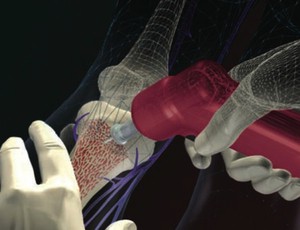Double intraosseous access has the potential to augment resuscitation

Double anatomic site IO catheter placement has the potential to augment resuscitation in cases where vascular access is challenging. We sought to compare flow rates and complications among 4 single and double anatomic site transfusion strategies in a swine model of hemorrhagic shock” Sulava et al (2018). Extract: “The American College of Surgeons Advance Trauma […]
Study of four intraosseous blood transfusion strategies

Intraosseous (IO) access is used by military first responders administering fluids, blood, and medications. Current IO transfusion strategies include gravity, pressure bags, rapid transfusion devices, and manual push-pull through a three-way stopcock” Auten et al (2018). Abstract: BACKGROUND: Intraosseous (IO) access is used by military first responders administering fluids, blood, and medications. Current IO transfusion […]
Intraarticular extravasation following intraosseous needle intravenous access

Off label use of intraosseous needles (IONs) for contrast media (CM) injection during computed tomographic angiography (CTA) has been reported in small case series and isolated case reports” Winkler et al (2018). Abstract: Off label use of intraosseous needles (IONs) for contrast media (CM) injection during computed tomographic angiography (CTA) has been reported in small […]
What is the usability of intraosseous blood samples in emergency care patients

The aim of this study was to systematically review the existing literature on the usability of IO blood samples for analysing the parameters relevant to emergency care. We performed a data search from the Medline and Embase databases, the Cochrane Library and the Clinical trials registry” Jousi et al (2018). Abstract: Intraosseous (IO) access is […]
Intraosseous access device comparison of efficacy

As an alternative, medications and fluids can be administered via the intraosseous (IO) route, which is a well-tolerated and established alternative, especially in the emergency setting” Szarpak et al (2018). Abstract: BACKGROUND: Obtaining intravascular access can be challenging or even impossible in several clinical situations. As an alternative, medications and fluids can be administered via […]
Study offers comparison of four intraosseous access devices
“The aim of the study was to compare the success rate, procedure time, and user satisfaction of pediatric NIO™ compared to Pediatric BIG®, EZ-IO®, and Jamshidi intraosseous access devices” Bielski et al (2017).
This article compares two intraosseous access devices

“During resuscitation in the field, intraosseous (IO) access may be achieved using a variety of available devices, often attempted by inexperienced users” Shina et al (2016).
Review of adult intraosseous access by advanced EMTs

“This study compares successful IO access in adults performed by AEMTs compared to Paramedics in the prehospital setting” Wolfson et al (2016).
Which is the best device for intraosseous access?

“The experiments with first-time users applying EZ-IO and FASTR in body donors indicate that both devices may be effective intraosseous infusion devices” Hammer et al (2015).
Comparison of two intraosseous devices in adult patients

“Both EZ-IO and BIG are shown to be reliable and safe methods for insertion of intravascular access in emergency conditions.” Demir et al (2014).
Rapid sequence induction of anaesthesia via the intraosseous route

“We aimed to assess the feasibility of the administration of RSI drugs via an IO catheter in a prospective observational study” Barnard et al (2014).
Comparison of muscle paralysis after intravenous and intraosseous administration of succinylcholine

“Succinylcholine can be effectively administered via the IO route. However, an increased dose may be necessary when administering succinylcholine via the IO route to achieve the same rapid onset as standard IV dosing” Loughren et al (2014).
Intraosseous needle insertion video in clinical practice

“Intraosseous needle insertion is used as a temporary measure when intravascular access cannot be achieved through peripheral or central venous routes” Dev et al (2014).
Intraosseous cannulation of the tibia results in amputation

“We present a case of a newborn girl, where intraosseous cannulation of the tibia was lifesaving. Despite following most standard recommendations, the treatment resulted in transtibial amputation due to necrosis” Oesterlie et al (2014).
Leg ischemia complicating the intraosseous infusion of epinephrine

“It can be used to administer the same treatments as intravenous infusion. It does, nonetheless, present some rare complications, such as acute leg ischemia by extravasation of epinephrine, as we report here” Maurin et al (2014).
Overall intraosseous complication rate was 2.1%

“In a literature search, we identified 5,759 patients treated with IO catheters. The overall complication rate was 2.1%. In this article, we discuss the literature on IO catheter complications and report 2 cases of orthopedic management of IO catheter complications” Barlow and Kuhn (2014).

